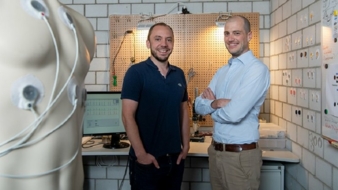09/11/2022 — auf Deutsch lesen
Textile electrodes for medtech applications
Nahtlos, an Empa spin-off, has developed novel textile-based electrodes for recording heart activity and for electrostimulation therapies.
Textile-based electrodes enable gentle and skin-friendly application, even if the electrodes have to be worn for several days or even weeks. The textile electrode is thus the first alternative to the gel electrode, which was developed 60 years ago and is still considered the standard for medical applications today.
Nahtlos founder and former Empa researcher Michel Schmid and co-founder and business economist José Näf have further developed the textile-based technology, which was developed and patented at Empa in various projects funded by Innosuisse, among others. The goal was to produce a product for long-term medical applications that reliably records ECG signals for up to several weeks, achieves a high level of patient acceptance and is cost-effective for the healthcare provider. Today, the patent for textile-based electrode technology is owned by Nahtlos after reaching a milestone.
Financing by business angels and Startfeld Foundation
Schmid and Näf were looking for investors to certify their product, set up production and develop the market – and found what they were looking for: In a seed financing round, the two young entrepreneurs were able to acquire 1 million Swiss francs from business angels from Switzerland and Liechtenstein as well as from the Startfeld Foundation. Nahtlos was supported in setting up its company by Startfeld, the start-up promotion arm of Switzerland Innovation Park Ost (SIP Ost), in the form of coaching, consulting and early-stage financing. Nahtlos is also based in the Innovation Park Ost, where innovations are initiated and accelerated through collaboration between start-ups, companies, universities and research institutions.

